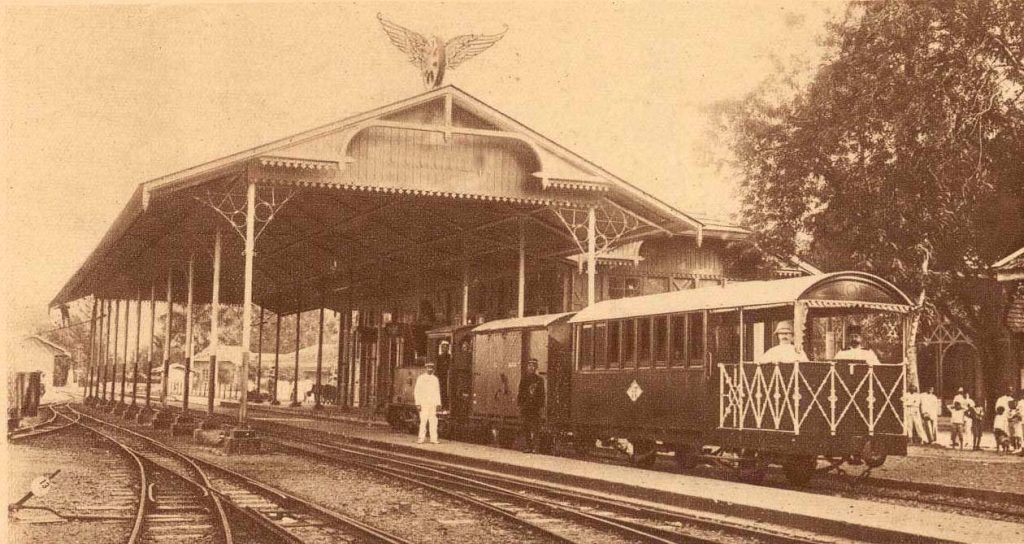
Railway development in Jakarta has a long history. One such historical railroad is the route between Jakarta and Bogor, originally used to transport plantation commodities from Priangan, West Java, to the city. Today the rail route is still one of the busiest, but its cargo has changed, shuttling commuters and those looking for opportunity in the capital.
Rail-based transportation — such as KRL, LRT and the new MRT — is the mainstay mode of public transportation for the people of Jakarta and also for the satellite cities, such as Bogor, Depok, Tangerang, and Bekasi. Free from the rampant traffic jams of the city, these journeys offer a fast, reliable service. And, unlike other regions in Indonesia, Jakarta’s railroad system is actually growing, and slowly integrating with other social aspects of the city.
Looking a little at the history of Indonesia’s railways during the Dutch colonial era, the construction of the railroad was the largest infrastructure project in the mid-19th century and was a milestone moment of western technology being used in the Dutch East Indies. The idea of building a railway in the Dutch East Indies had actually been underway since 1840, but long debates about the track and its management among officials caused delays. Finally the construction of the railway network on the island of Java was carried out by the private sector. A private railway company, NV Nederlandsche Indisch Spoorweg Maatschappij (NISM), was founded by three entrepreneur W. Poolman, Alex Frazer, dan E.H. Kol. NISM’s old head office still stands in central Semarang, now known as Lawang Sewu (‘Thousand Doors’).

“Railways in Indonesia were built for the first time in Semarang with a track width of 1,435 mm on 17 June 1864, the construction of which was initiated by NISM. In the past, there were many railway companies, unlike now, where the management is done by a government company, namely KAI. Then the second permit for the construction of a railway granted by the Dutch East Indies government was to build a railway line in Jakarta with the Batavia (Jakarta)-Buitenzorg (Bogor) route.” Kartum Setiawan, a historian and an author of the book Kereta Api di Jakarta (Railway in Jakarta), explained to NOW! Jakarta.
The permission given to William Poolman through NISM on 27 March 1864 was to build the Batavia-Buitenzorg line to assist in the transportation of plantation products including cultuurstelsel (enforced planting) produce in the West Priangan area (Priangan: Parahiyangan or Parahyangan in Sundanese or Preanger in Dutch is a cultural and mountainous area in the province of West Java), such as tea, coffee, quinine, and other trade products to the Port of Sunda Kelapa (Batavia).
“In a political view, the construction of the Batavia-Buitenzorg route is very important because the centre of government was not only in Batavia but also at the Bogor Palace. So the Dutch East Indies government saw the potential for transportation as politically important to expedite government-administrative relations. Moreover, since 1808 the governor general has resided in Buitenzorg. So, if we observe the Bogor Station building, it is magnificent compared to other stations. This was the main difference between the train lines in Semarang and Jakarta, as the latter’s function was not only to transport commodities but also to the government officials.” Kartum continued.

The construction of the Batavia-Buitenzorg line was done on 16 October 1869 and was led by J.P. Borders. It was marked by the presence of Governor General Pieter Mijer (1866-1872). The slow development was caused by a technical change in the adjustment of the gauge width from 1,435 mm to 1,067 mm. Changes were made due to NISM experiencing financial difficulties when building the Kemijen-Tanggung line in Semarang (1864-1867). With the change, the budget could be reduced significantly (from 4,000,000 guiden to 3,311,250 guiden — saving a toatl of 806,300 guiden) and this made the gauge width of 1.067 commonly used in the Dutch East Indies going forward.
The construction of the railroad in Jakarta was carried out in three stages. First, the Kleine Boom (Pasar Ikan or Sunda Kelapa)-Batavia Noord-Koningsplein (Weltevreden or Gambir) route operated on 15 September 1871, for 9 kilometres with a 14 passenger-car. The second phase, the construction of the Koningsplein-Meester Cornelis Passer Station or Gambir-Bukit Duri (now Manggarai station) route which began operating on1 6 June 1872.
And, for the third phase, the Bukit Duri-Buitenzorg (Jakarta-Bogor) route was built, whose operations were inaugurated on 31 January 1873. Since then, Batavia-Buitenzorg can be passed by train and was open to the public. The total length of the railroad was 58,506 m, consisting of 55,580 m of the Batavia-Buitenzorg direct line, 1,058 m of branch-off rail route to Bukit Duri and a 1,868 m of branch-off rail route to the Pasar Ikan.
Two years later, the Dutch East Indies government established a railroad company called Staatsspoorwegen (SS) in 1875. The Jakarta-Bogor line was taken over by the SS.
At the time of the inauguration of the third stage of the line, a party was held at the French-owned Hotel du Chemin du Fer. This hotel was in the south of the Buitenzorg station which was used by travelers who used the train to stay. Currently the building is used as the Bogor City Police Headquarters office (Polresta Bogor).
“The Jakarta-Bogor railway line is quite special compared to railway lines in other regions in Indonesia. Why? Because the railway lines in Jakarta tend to develop while in other areas they’re dead, such as Banjar-Pangandaran, Semarang-Cepu, and many more. Because commodity transportation has been replaced by buses or cars. But in Jakarta it is developing, what used to be only one track, then it has become two lanes and until now there is a double-double track. One of the factors that make it grow is urbanisation.” said Kartum.
Since the construction of the Batavia-Buitenzorg line, there have been 15 station buildings and shelters: Pasar Ikan, Batavia Noord (Stasiun Utara), Sawah Besar, Noordwijk (Juanda), Gambir, Pegangsaan, Bukit Duri, Pasar Minggu, Lenteng Agung, Pondok Cina, Depok, Citayam, Bojonggede, Cilebut, and Bogor. Along with the development of the population in Jakarta and its surroundings, the number of stations has increased and the shelters have been upgraded to become stations. According to Kartum, the Depok Baru, Universitas Indonesia, Pancasila, Tanjung Barat, Pasar Minggu Baru, and Cawang stations are part of the station development.

According to Kartum, talking about trains means talking about networks. Since the construction of the existing rail network in Jakarta, Bogor, Tangerang, Bekasi, new residential centres have been formed for residents, offices and government. In fact, one of the selling points for marketing a residence is if it is close to the station.The station is the transportation centre for urban communities to go to work. Then, increased development includes electrification and modernisation of facilities and infrastructure.
“The Jakarta-Bogor route is already 150 years old. We can still see and be nostalgic for that long history by taking a trip back on the commuter line train, starting from Manggarai station which is full of history, one of which was President Soekarno and his family using the Kereta Api Luar Biasa (Extraordinary Train) from Manggarai-Pegangsaan-Yogyakarta 3 January 1946 when the capital was moved in a night. Then, to Kalibata station to see one of its historical heritage: a substation building for train electricity supply which still bears the ESS (Electric Staatsspoorwegen) logo. Or to Citayam station where there is a supporting building at the counter that was used as the station head’s official residence. The roof and tiles are still original. And, in Bogor you can see the VIP room which was used by the governor general of the Dutch East Indies and state guests waiting for trains up to the third floor where all the buildings are still original.” Kartum, who is also a tour guide, suggested.
From this trip, maybe you can imagine the rapid development of trains in Jakarta. In the past, two weeks after operating the NISM trains could carry 35,740 passengers or an average of 2,383 people per day. Currently, based on 2022 data, PT Kereta Commuter Indonesia (KCI) operates trains for 1,081 trips per day, Monday-Friday in the Greater Jakarta area with an average number of passengers of 800,000 to 1.2 million passengers per day. The Jakarta-Bogor line dominates by operating 384 trips per day.







